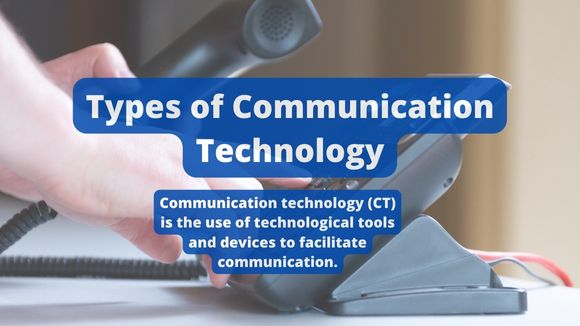Nowadays, people are more connected with each other because of the advancement in technology, which essentially erased distances and borders. A person living in New York can have a real-time conversation with a friend living on the other side of the world. Notwithstanding this type of progress, effective communication within organizations, companies, and businesses is sometimes not readily achieved.

There are many types of communication technologies that exist in the world today. Some are more popular than others, but all have their unique benefits and drawbacks. In this blog post, we will explore the most common communication technologies and describe what makes them so special.
Table of Contents
What Is Communication Technology?
Communication technology (CT) is the use of technological tools and devices to facilitate communication. This can include everything from email and text messaging to video conferencing and social media.
CT can be used to communicate with people around the world in real-time or to send messages and information instantaneously. It has revolutionized the way we work, play, and interact with one another. Whether we are using it to stay in touch with friends and family or to connect with colleagues and clients, CT has become an essential part of our lives.
As our world becomes increasingly interconnected, communication technology will continue to play a vital role in how we communicate with one another.
How Does Communication Technology Work?
There are a few key components that make communication technology work. These include:
- A sender: the person who creates and sends the message
- A receiver: the person who receives and interprets the message
- A channel: the medium through which the message is sent (e.g., email, text, phone call, etc.)
- A message: the information that is being communicated
The sender encodes the message into a format that can be sent through the chosen channel. The receiver then decodes the message and interprets its meaning. In order for communication to be effective, both the sender and the receiver must be on the same page regarding the message and its interpretation.
Differrent Types of Communication Technologies
There are a variety of communication channels that can be used, each with its own advantages and disadvantages. The most popular channels include:
Telephone
The telephone is one of the oldest and most commonly used communication technologies. It is one of the most important inventions of the modern era. Not only does it allow us to communicate with others at a distance, but it also conveys electrical messages over wires. This means that instead of staccato clicks, which need the training to interpret, telephone cables can transport genuine speech sounds.
This technology has revolutionized communication, making it possible for people all over the world to connect instantly. It is hard to overestimate the importance of the telephone in the modern world. It is a quick and easy way to send and receive information. However, it can be expensive to use long-distance, and there is always the possibility of dropped calls or poor reception.
Fax machine
The fax machine was once the primary method of sending documents electronically. A fax machine is a machine that uses a telephone line to send and receive documents.
The sender places the document to be faxed in the machine, dials the number of the fax machine at the receiving end, and the document is transmitted over the phone line. At the receiving end, the fax machine prints out the document.
Fax machines are commonly used to send and receive business documents, such as contracts, invoices, and reports. They are also occasionally used to send personal documents, such as letters and family photos. Fax machines have been around for several decades and are still in use today, although their popularity has declined in recent years with the advent of email and other digital communication methods.
Faxes can be sent and received quickly and easily, but they can be costly to use long-distance. In addition, fax machines require a dedicated phone line, which can be an issue for small businesses or home offices.
Radio
Radio is a communication technology that uses electromagnetic waves to transmit sound. It is one of the earliest forms of wireless communication. Radio waves are used to carry signals from one place to another, and they can travel long distances.
Radio was first used for communication in the late 1800s, and it quickly became a popular way to send and receive information. Radio is still widely used today, both for commercial purposes and for personal use. It is an effective way to communicate over long distances, but it can be expensive to set up and maintain a radio station.
Television
Television is a broadcast medium that uses electromagnetic waves to transmit moving images and sound. Television signals are typically transmitted via satellite, cable, or over-the-air broadcasting.
Television was first developed in the early 1900s, and it has become one of the most popular forms of entertainment and information in the world. Television is an effective way to reach a large audience with a message or story. However, it can be expensive to produce quality television programming, and there is always the risk that viewers will change the channel if they are not interested in what is being shown.
VoIP
VoIP (Voice over Internet Protocol) is a type of telecommunications that allows users to make and receive phone calls using the internet instead of a traditional phone line. VoIP can be used for personal or business purposes.
For example, VoIP can be used to make international calls, which can be much cheaper than traditional phone calls. VoIP can also be used to set up a virtual office, which can be a convenient and cost-effective way to run a business.
VoIP has many benefits, but it also has some drawbacks. For example, VoIP calls can be prone to dropped calls or choppy audio quality. Additionally, VoIP requires a reliable internet connection, which may not be available in all areas. Despite these challenges, VoIP remains a popular and essential communication tool for many businesses.
Teleconferencing
Teleconferencing is a type of telecommunications that allows users to communicate with each other using audio only. Teleconferencing can be used for personal or business purposes.
For example, teleconferencing can be used to hold meetings with colleagues or clients who are located in different parts of the world. It can also be used to conduct job interviews, give presentations, or provide training.
Teleconferencing has many benefits, but it also has some drawbacks. For example, it can be difficult to schedule teleconferences, due to time zone differences. Additionally, teleconferences can be less personal than video conferences or in-person meetings. Despite these challenges, teleconferencing remains a popular and essential communication tool for many businesses.
Email is a widely used communication tool that allows people to send and receive messages electronically, especially in the business world. Email allows users to send and receive messages from anywhere in the world, at any time of day.
Email messages can be short or long, and can include attachments such as documents, images, and videos. Email is an efficient way to communicate with friends, family, colleagues, and business contacts. It is also a convenient way to stay up-to-date on current events, news, and other information.
Email has many benefits, but it also has some drawbacks. For example, email can be used to send spam or unwanted messages. It can also be used to spread viruses and other malicious software. Despite these risks, email remains a popular and essential communication tool for millions of people around the world.
Text messaging
Text messaging, also known as SMS (short message service), is a popular way to communicate, especially among young people. Text messages are sent and received using a mobile phone. They are typically shorter than email messages, and can only include text, not images or videos.
Text messaging is fast, convenient, and relatively inexpensive. It is often used for informal communication, such as sending a quick message to a friend or family member. However, it can also be used for business purposes, such as sending reminders or updates to employees.
Text messaging has become so popular that some people have started to use it as a replacement for email and other forms of communication. This has led to concerns about the potential negative effects of text messaging, such as distraction, addiction, and poor grammar. Despite these concerns, text messaging remains a popular way to communicate, both in personal and professional settings.
Instant messaging
Making voice calls is just not enough anymore in today’s daily activities. Businesses must learn to adapt to this by grabbing the advantages a real-time chat can give. Instant messaging (IM) is a real-time communication tool that allows users to send and receive messages online. IM messages are typically shorter than email messages and can include text, images, videos, and other media.
IM is fast, convenient, and relatively inexpensive. It is often used for informal communication, such as sending a quick message to a friend or family member. However, it can also be used for business purposes, such as sending reminders or updates to employees.
Customers will surely appreciate not waiting for someone to talk to when making a voice call. They can do something else while waiting for a response while chatting. Even employees of a company can benefit from having an internal chatting platform.
IM has become so popular that some people have started to use it as a replacement for email and other forms of communication. This has led to concerns about the potential negative effects of IM, such as distraction, addiction, and poor grammar. Despite these concerns, IM remains a popular way to communicate, both in personal and professional settings.
Video Calling
Nowadays, video calling is becoming more popular than voice calls because it provides an efficient way to communicate with friends, family members, and colleagues without having to be in the same room or even country.
With video calling, people can see the person they are talking to instead of just hearing their voice. This can be helpful for many reasons, such as getting feedback on a project or simply catching up with someone’s day-to-day activities.
Companies can benefit from utilizing this type of technology. Deals and transactions could be made without leaving the office. There’s no need to take those expensive business trips anymore.
A company executive can talk with his counterpart from another country and close a business deal effectively, just like a face-to-face meeting would do. Also, multiple parties from different places can be accommodated in a single video calling session. Imagine how productive that could be.
Video calling has many benefits, but it also has some drawbacks. For example, it can be expensive if used regularly. It can also be difficult to use if the internet connection is poor or if the other person’s device does not have a camera installed. Despite these risks, video calling remains a popular and essential communication tool for many people around the world
Video conferencing
Video conferencing is a type of telecommunications that allows users to communicate with each other using audio and video. Video conferencing can be used for personal or business purposes.
For example, video conferencing can be used to hold face-to-face meetings with colleagues or clients who are located in different parts of the world. It can also be used to conduct job interviews, give presentations, or provide training.
Video conferencing has many benefits, but it also has some drawbacks. For example, it can be expensive to set up and maintain a video conferencing system. It can also be difficult to schedule video conferences, due to time zone differences. Despite these challenges, video conferencing remains a popular and essential communication tool for many businesses.
Social media
Social media is a category of online communication platforms that allow users to share content, connect with friends and acquaintances, and engage in other online activities. Social media platforms include Facebook, Twitter, Instagram, Snapchat, and LinkedIn.
Social media has revolutionized communication, making it possible for people all over the world to connect instantly. It is a quick and easy way to share information and stay up-to-date on what is happening in the world. However, social media can also be a source of misinformation, and it can be addictive.
Project management software
Project management software is a type of computer program that helps people plan, track, and organize tasks and projects. Slack and Trello are two popular examples of project management software.
Project management software is commonly used by businesses to help team members collaborate on tasks and projects. It is a quick and easy way to communicate with others and stay organized. However, project management software can be expensive to purchase and maintain, and it can be challenging to learn how to use all of the features.
Blog and vlog
A blog is a type of website that typically contains text, images, and videos. Blogs are usually maintained by an individual or a small group of people.
Vlogs (video blogs) are a type of blog that consists primarily of videos. Vloggers often film themselves talking about their day-to-day lives, thoughts, and experiences.
Blogs and vlogs are popular because they are easy to create and maintain. They are also a great way to connect with others who have similar interests. However, blogging and vlogging can be time-consuming, and it can be difficult to stand out in the crowded online space.
Live video streaming
Live video is a fairly new concept that has taken the internet by storm. It allows content creators to connect with their audience in real-time, providing an authentic and immediate experience.
This type of content is highly engaging, as it feels more personal and intimate than pre-recorded videos. In addition, live video is unedited and unscripted, giving viewers a sense of authenticity and transparency.
Gamers have taken advantage of live video streaming to share their gaming experiences with the world. Platforms like Twitch allow gamers to stream their gameplay live, and sometimes for hours on end.
This has become incredibly popular, as it allows gamers to connect with other gamers and share tips and tricks. It also allows viewers to get a behind-the-scenes look at how video games are made.
While live streaming does have its advantages, it also presents some challenges. For example, live video can be unpredictable and chaotic, which can be off-putting for some viewers. Additionally, if something goes wrong during a live broadcast, there is no way to edit it out or start over. Despite these challenges, live video is a popular vlogging extension that continues to grow in popularity.
Mobile Technology
Using mobile technology to its full potential could make a business grow and expand much faster. Almost everyone uses their mobile phones not only for communication but also for paying bills, shopping, banking, watching the news, etc. Businesses should employ the use of applications to promote their products or services to their target customers.
By utilizing the full potential of this rapidly growing industry, businesses can expand and grow at an unprecedented rate. As mobile technology continues to develop, businesses will have ever-greater opportunities to reach their target audiences. Through the use of applications, businesses can promote their products and services directly to consumers’ mobile devices. In an increasingly competitive marketplace, those businesses that embrace mobile technology will be well positioned to succeed.
Wearable devices
A lot of industries benefit from wearing devices that can be used for communicating and even to store retrievable information as well. Just take a look at those delivery guys that brought you the food that you ordered.
Those people are using wearable technology like smartwatches or even just through their mobile phones, which use GPS technology to be able to get to your house. It’s a breakthrough for businesses to provide delivery service to their customers.
The Internet
The Internet has become an essential part of communication technology. It allows people to connect on a global scale, and it has revolutionized the way we communicate.
The Internet has made it possible for us to communicate with anyone, anywhere in the world, and it has given us access to a wealth of information. In addition, it has allowed us to communicate in ways that were once impossible. For example, we can now communicate through text, audio, and video.
The Internet has also changed the way we do business. It has allowed us to conduct transactions electronically, and it has given us access to a global marketplace. As a result, businesses can now reach a larger audience than ever before.
The Internet has had a profound impact on our lives, and it is likely to have even more impact in the years to come. It is changing the way we live and work, and it is paving the way for a new era of communication.



